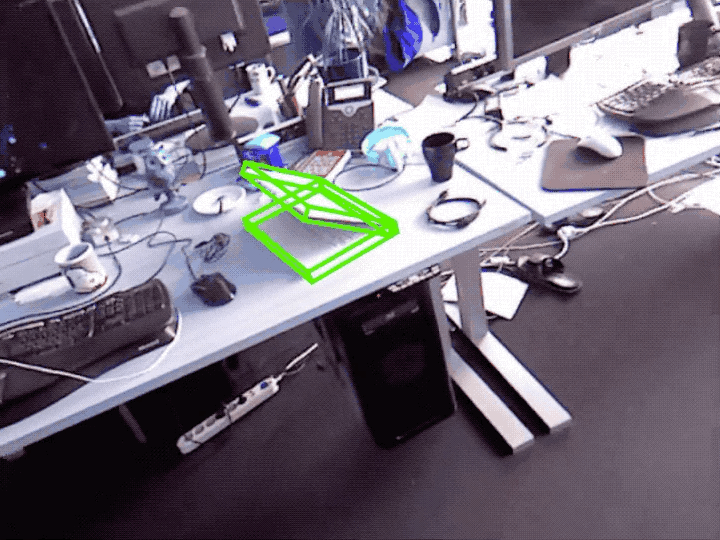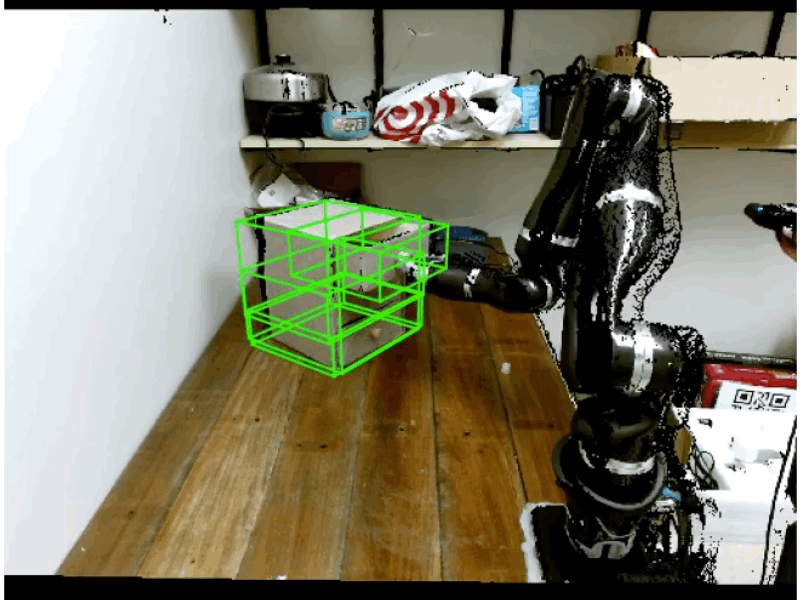CAPTRA
CAPTRA: CAtegory-level Pose Tracking for Rigid and Articulated Objects from Point Clouds
This is the official PyTorch implementation of our paper CAPTRA: CAtegory-level Pose Tracking for Rigid and Articulated Objects from Point Clouds. This repository is still under construction.
For more information, please visit our project page.


<b>Result visualization on real data.</b> Our models, trained on synthetic data only, can directly generalize to real data, assuming the availability of object masks but not part masks. Left: results on a laptop trajectory from BMVC dataset. Right: results on a real drawers trajectory we captured, where a Kinova Jaco2 arm pulls out the top drawer.</p>
Citation
If you find our work useful in your research, please consider citing:
@article{weng2021captra,
title={CAPTRA: CAtegory-level Pose Tracking for Rigid and Articulated Objects from Point Clouds},
author={Weng, Yijia and Wang, He and Zhou, Qiang and Qin, Yuzhe and Duan, Yueqi and Fan, Qingnan and Chen, Baoquan and Su, Hao and Guibas, Leonidas J},
journal={arXiv preprint arXiv:2104.03437},
year={2021}
Updates
- [2021/04/14] Released code, data, and pretrained models for testing & evaluation.
- [2021/04/22] Released code and data for training.
Installation
-
Our code has been tested with
- Ubuntu 16.04, 20.04, and macOS(CPU only)
- CUDA 11.0
- Python 3.7.7
- PyTorch 1.6.0
-
We recommend using Anaconda to create an environment named
captradedicated to this repository, by running the following:conda env create -n captra python=3.7 conda activate captra -
Create a directory for code, data, and experiment checkpoints.
mkdir captra && cd captra -
Clone the repository
git clone https://github.com/HalfSummer11/CAPTRA.git cd CAPTRA -
Install dependencies.
pip install -r requirements.txt -
Compile the CUDA code for PointNet++ backbone.
cd network/models/pointnet_lib python setup.py install
Datasets
-
Create a directory for all datasets under
captramkdir data && cd data- Make sure to point
basepathinCAPTRA/configs/obj_config/obj_info_*.ymlto your dataset if you put it at a different location.
- Make sure to point
NOCS-REAL275
mkdir nocs_data && cd nocs_data
Test
-
Download and unzip nocs_model_corners.tar, where the 3D bounding boxes of normalized object models are saved.
wget http://download.cs.stanford.edu/orion/captra/nocs_model_corners.tar tar -xzvf nocs_real_corners.tar -
Create
nocs_fullto hold original NOCS data. Download and unzip "Real Dataset - Test" from the original NOCS dataset, which contains 6 real test trajectories.mkdir nocs_full && cd nocs_full wget http://download.cs.stanford.edu/orion/nocs/real_test.zip unzip real_test.zip -
Generate and run the pre-processing script
cd CAPTRA/datasets/nocs_data/preproc_nocs # generate the script for data preprocessing # parallel & num_proc specifies the number of parallel processes in the following procedure python generate_all.py --data_path ../../../../data/nocs_data --data_type=test_only \ --parallel --num_proc=10 > nocs_preproc.sh # the actual data preprocessing bash nocs_preproc.sh -
After the steps above, the folder should look like File Structure - Dataset Folder Structure.
Train
-
Download and unzip "CAMERA Dataset - Training/Test" and "Real Dataset - Training" from the original NOCS dataset under
nocs_data/nocs_full# current path relative to project root (captra): data/nocs_data/nocs_full wget http://download.cs.stanford.edu/orion/nocs/camera_train.zip unzip camera_train.zip wget http://download.cs.stanford.edu/orion/nocs/camera_val25K.zip unzip camera_val25K.zip wget http://download.cs.stanford.edu/orion/nocs/real_train.zip unzip real_train.zip-
By now,
nocs_fullshould be structured as follows. Note that the depth image (*_depth.png) only contains the synthetic foreground objects. For our purpose, we need a complete depth image composing both the synthetic foreground and the real background.nocs_full ├── real_test ├── real_train ├── train │ ├── 00000 │ │ ├── 0000_color.png, 0000_coord.png, 0000_depth.png, 0000_mask.png, 0000_meta.txt │ │ ├── 0001_color.png, ... │ │ └── ... │ ├── 00001 │ └── ... └── val # same structure as train
-
-
Download and unzip "CAMERA Dataset - Composed_depths" from the original NOCS dataset under
nocs_data.cd ../ # current path relative to project root (captra): data/nocs_data wget http://download.cs.stanford.edu/orion/nocs/camera_composed_depth.zip unzip camera_composed_depth.zipThis will result in a folder named
camera_full_depths, structured as follows.camera_full_depths ├── train │ ├── 00000 │ │ ├── 0000_composed.png # depth image containing both synthetic foreground objects │ │ │ # and the real background │ │ ├── 0001_composed.png # rendered object normalized coordinates │ │ └── ... │ ├── 00001 │ └── ... └── val # same structure as trainThen copy-merge
camera_full_depthswithnocs_full.# merge camera_full_depth/train/????? to nocs_full/train/????? rsync -arv camera_full_depths/ nocs_full/ rm -r camera_full_depths -
Generate and run the pre-processing script
cd CAPTRA/datasets/nocs_data/preproc_nocs python generate_all.py --data_path ../../../../data/nocs_data --data_type=all --parallel --num_proc=10 > nocs_preproc_all.sh # generate the script for data preprocessing # parallel & num_proc specifies the number of parallel processes in the following procedure bash nocs_preproc_all.sh # the actual data preprocessing -
After the steps above, the folder should look like [File Structure - Dataset Folder Structure](#File Structure).
SAPIEN Synthetic Articulated Object Dataset
mkdir sapien_data && cd sapien_data
Test
-
Download and unzip object URDF models and testing trajectories
wget http://download.cs.stanford.edu/orion/captra/sapien_urdf.tar wget http://download.cs.stanford.edu/orion/captra/sapien_test.tar tar -xzvf sapien_urdf.tar # urdf tar -xzvf sapien_test.tar # render_seq
Train
-
Download and unzip training data.
wget http://download.cs.stanford.edu/orion/captra/sapien_train.tar tar -xzvf sapien_train.tar # render
Testing & Evaluation
Download Pretrained Model Checkpoints
-
Create a folder
runsundercaptrafor experimentsmkdir runs && cd runs -
Download our pretrained model checkpoints for
- NOCS-REAL275: nocs_ckpt.tar
- SAPIEN synthetic articulated object dataset: sapien_ckpt.tar
-
Unzip them in
runstar -xzvf nocs_ckpt.tarwhich should give
runs ├── 1_bottle_rot # RotationNet for the bottle category ├── 1_bottle_coord # CoordinateNet for the bottle category ├── 2_bowl_rot └── ...
Testing
-
To generate pose predictions for a certain category, run the corresponding script in
CAPTRA/scripts/track(without further specification, all scripts are run fromCAPTRA), e.g. for the bottle category from NOCS-REAL275,bash scripts/track/nocs/1_bottle.sh -
The predicted pose will be saved under the experiment folder
1_bottle_rot(see File Structure - Experiment Folder Structure). -
To test the tracking speed for articulated objects in SAPIEN, make sure to set
--batch_size=1in the script. You may use--dataset_length=500to avoid running through the whole test set.
Evaluation
-
To evaluate the pose predictions produced in the previous step, uncomment and run the corresponding line in
CAPTRA/scripts/eval.sh, e.g. for the bottle category from NOCS-REAL275, the corresponding line ispython misc/eval/eval.py --config config_track.yml --obj_config obj_info_nocs.yml --obj_category=1 --experiment_dir=../runs/1_bottle_rot
Training
-
To train the CoordinateNet and RotationNet for a certain category, run the corresponding script in
CAPTRA/scripts/train, e.g. for the bottle category from NOCS-REAL275, scripts can be found inCAPTRA/scripts/train/nocs/1_bottle.sh.# RotationNet python network/train.py --config=config_rotnet.yml --obj_config=obj_info_nocs.yml \ --pose_perturb/r=5.0 --pose_perturb/t=0.03 --pose_perturb/s=0.02 \ --batch_size=12 \ --obj_category=1 \ --experiment_dir=../runs/1_bottle_rot_new \ --use_val=real_test \ --num_workers=2 # CoordinateNet python network/train.py --config=config_coordnet.yml --obj_config=obj_info_nocs.yml \ --pose_perturb/r=5.0 --pose_perturb/t=0.03 --pose_perturb/s=0.02 \ --batch_size=12 \ --obj_category=1 \ --experiment_dir=../runs/1_bottle_coord_new \ --use_val=real_test \ --num_workers=2 -
The output logs and checkpoints will be saved at
1_bottle_rot_new/log,1_bottle_rot_new/ckpt, respectively. (see [File Structure - Experiment Folder Structure](#File Structure)). -
For NOCS dataset, after training the models using synthetic data, we can further finetune them with real training data. To do this, simply replace
train.pywithtrain_nocs_finetune.pyin the training script. Use--syn_nand--real_onlyto adjust the proportion of real/synthetic training data used in each epoch.
File Structure
Overall Structure
The working directory should be organized as follows.
captra
├── CAPTRA # this repository
├── data # datasets
│ ├── nocs_data # NOCS-REAL275
│ └── sapien_data # synthetic dataset of articulated objects from SAPIEN
└── runs # folders for individual experiments
├── 1_bottle_coord
├── 1_bottle_rot
└── ...
Code Structure
See here for an overview of our code. Only the most relevant folders/files are shown.
CAPTRA
├── configs # configuration files
│ ├── all_config # experiment configs
│ ├── pointnet_config # pointnet++ configs (radius, etc)
│ ├── obj_config # dataset configs
│ └── config.py # parser
├── datasets # data preprocessing & dataset definitions
│ ├── arti_data # articulated data
│ │ └── ...
│ ├── nocs_data # NOCS-REAL275 data
│ │ ├── ...
│ │ └── preproc_nocs # prepare nocs data
│ └── ... # utility functions
├── pose_utils # utility functions for pose/bounding box computation
├── utils.py
├── misc # evaluation and visualization
│ ├── eval
│ └── visualize
├── scripts # scripts for training/testing
└── network # main part
├── data # torch dataloader definitions
├── models # model definition
│ ├── pointnet_lib
│ ├── pointnet_utils.py
│ ├── backbones.py
│ ├── blocks.py # the above defines backbone/building blocks
│ ├── loss.py
│ ├── networks.py # defines CoordinateNet and RotationNet
│ └── model.py # defines models for training/tracking
├── trainer.py # training agent
├── parse_args.py # parse arguments for train/test
├── test.py # test
├── train.py # train
└── train_nocs_mix.py # finetune with a mixture of synthetic/real data
Experiment Folder Structure
For each experiment, a dedicated folder in `captra/runs` is created. See here for its organization.
1_bottle_rot
├── log # training/testing log files
│ └── log.txt
├── ckpt # model checkpoints
│ ├── model_0001.pt
│ └── ...
└── results
├── data* # per-trajectory raw network outputs
│ ├── bottle_shampoo_norm_scene_4.pkl
│ └── ...
├── err.csv** # per-frame error
└── err.pkl** # per-frame error
*: generated after testing with --save
**: generated after running misc/eval/eval.py
Dataset Folder Structure
See here for the organization of dataset folders.
nocs_data
├── nocs_model_corners # instance bounding box information
├── nocs_full # original NOCS data, organized in frames (not object-centric)
│ ├── real_test
│ │ ├── scene_1
│ │ └── ...
│ ├── real_train
│ ├── train # see the following
│ └── val
├── instance_list* # collects each instance's occurences in nocs_full/*/
├── render* # per-instance segmented data for training
├── preproc** # cashed data
└── splits** # data lists for train/test
*: generated after data-preprocessing
**: generated during training/testing
# Specifically, nocs_data/nocs_full/train (and val) should be structured as follows:
train
├── 00000
│ ├── 0000_coord.png # rendered object normalized coordinates
│ ├── 0000_depth.png # depth image containing synthetic foreground objects only
│ ├── 0000_mask.png # object mask
│ ├── 0000_meta.txt # meta information
│ ├── 0000_composed.png* # depth image containing both synthetic foreground objects
│ │ # and the real background
│ ├── 0000_pose.pkl** # object poses computed from *_coord.png and *_depth.png
│ └── ...
├── 00001
└── ...
*: generated after copy-merging camera_full_depths with nocs_full
**: generated after data-preprocessing
sapien_data
├── urdf # instance URDF models
├── render_seq # testing trajectories
├── render** # single-frame training/validation data
├── preproc_seq* # cashed testing trajectory data
├── preproc** # cashed testing trajectory data
└── splits* # data lists for train/test
*: generated during training/testing
**: training







